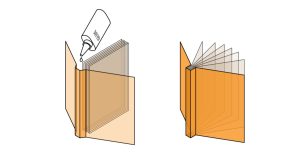What does it mean when a book is perfect bound?
Perfect binding is a commonly used form of book binding that uses glue to hold the pages and cover of the book together. The three sides of the book are then trimmed to give them clean, or “perfect” edges, hence the name: perfect binding.
Often books that use perfect binding feature a clear coated cover which helps to enhance the book’s appearance and provide extra durability. Perfect binding is not only used to bind books. Oftentimes, when a marketing brochure has more than 24 pages, the decision to perfect bind the brochure is made to enhance the look and feel of the piece, rather than saddle stitch.
The Perfect Binding Process
To better understand the perfect binding process, here is an account of how a perfect bound book is constructed.
The perfect binding process begins with pages being arranged in proper order, then stacked into a block. Abrasives are then used on the edge of the block to roughen it up, exposing paper fibers that will allow the glue to adhere more easily.
The glue is then applied to this edge and the cover is wrapped around the block of pages. Once the glue dries, the open edges of the book are trimmed leaving them nice and clean.
Related: What Book Binding Method is Right for Your Print Job?
Perfect Binding Use Cases
Perfect binding is a great solution for many books, but is not recommended for those that are less than 1/8” thick. This is because the narrow edges of these books do not provide enough surface area for the glue to bind the pages securely. For thinner books, saddle stitching or spiral coil binding may be recommended.
Perfect binding is also a great option because it is durable, economical and gives books a professional appearance. This method has the added benefit of allowing a surface large enough so that the title can be printed on the spine, making the book easier to identify. This convenience is not an option available with saddle stitch and spiral binding methods.
RELATED: WHAT’s in a Bind? 4 Types of Book Binding – Pros and Cons
WHEN TO NOT USE PERFECT BINDING
Although the perfect binding method might seem ideal, it comes with a variety of drawbacks, as well. Perfect bound books do not lay flat and, therefore, are not recommended for books that require hands-free reading.
The method is also limited to books that fall between the measurements of 1.25 inches and 2.25 inches. The turnaround time can be a bit longer for the process as well as perfect bound books may take a day longer to produce as compared to other methods.
Weigh your Binding Options
Those who are considering perfect binding may weigh their options carefully, but it remains a popular method for catalogs, directories and paperbacks that have a higher page count. There are many forms of book binding from which to choose. Research carefully to determine if perfect binding is the best option for you.
If you need help, feel free to contact our print experts for a consultation – we’ll set you on the right track with your brochures or books!




